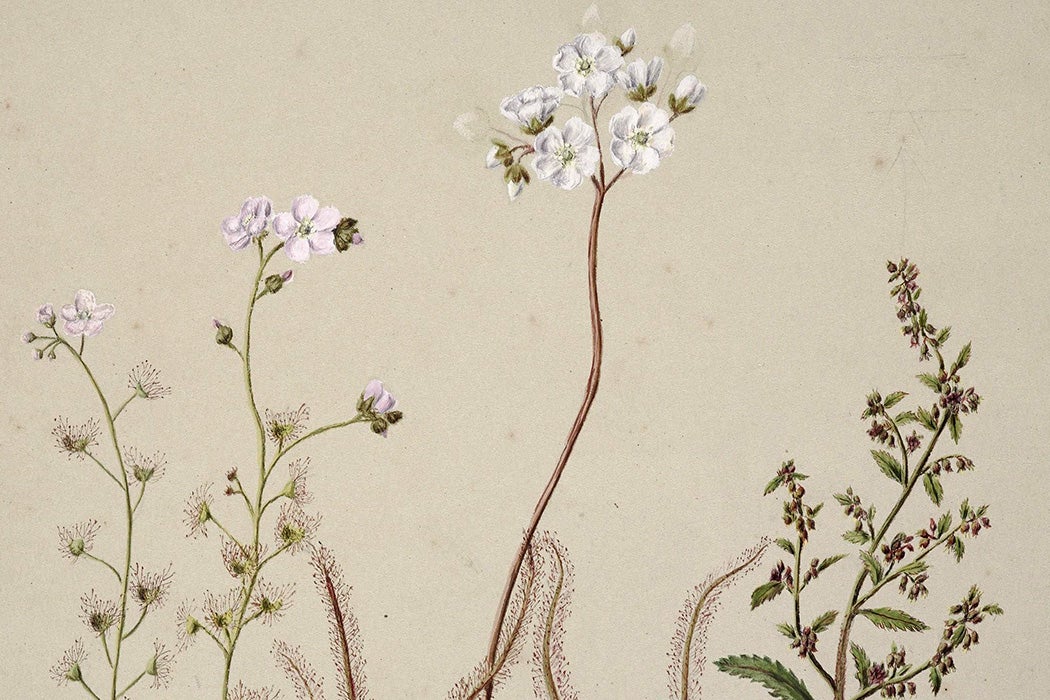Sundews, alongside other meat-eating denizens of the plant kingdom like pitcher plants and the Venus flytrap, have long occupied a special place in botanical popular culture. They are among the most visually striking carnivorous plants, which attract, trap, kill, and derive nutrients from insect prey in a manner often unsettlingly similar to that of an animal predator. The name sundew is derived from the hundreds of sticky mucilaginous hairs covering each leaf. Once an insect lands on its surface, there is no hope of escape, and the leaf gradually curls around its quarry, suffocating it. Indeed, the macabre nature of their deadly traps has inspired countless individuals to take a closer look at these beautiful but deadly carnivores.
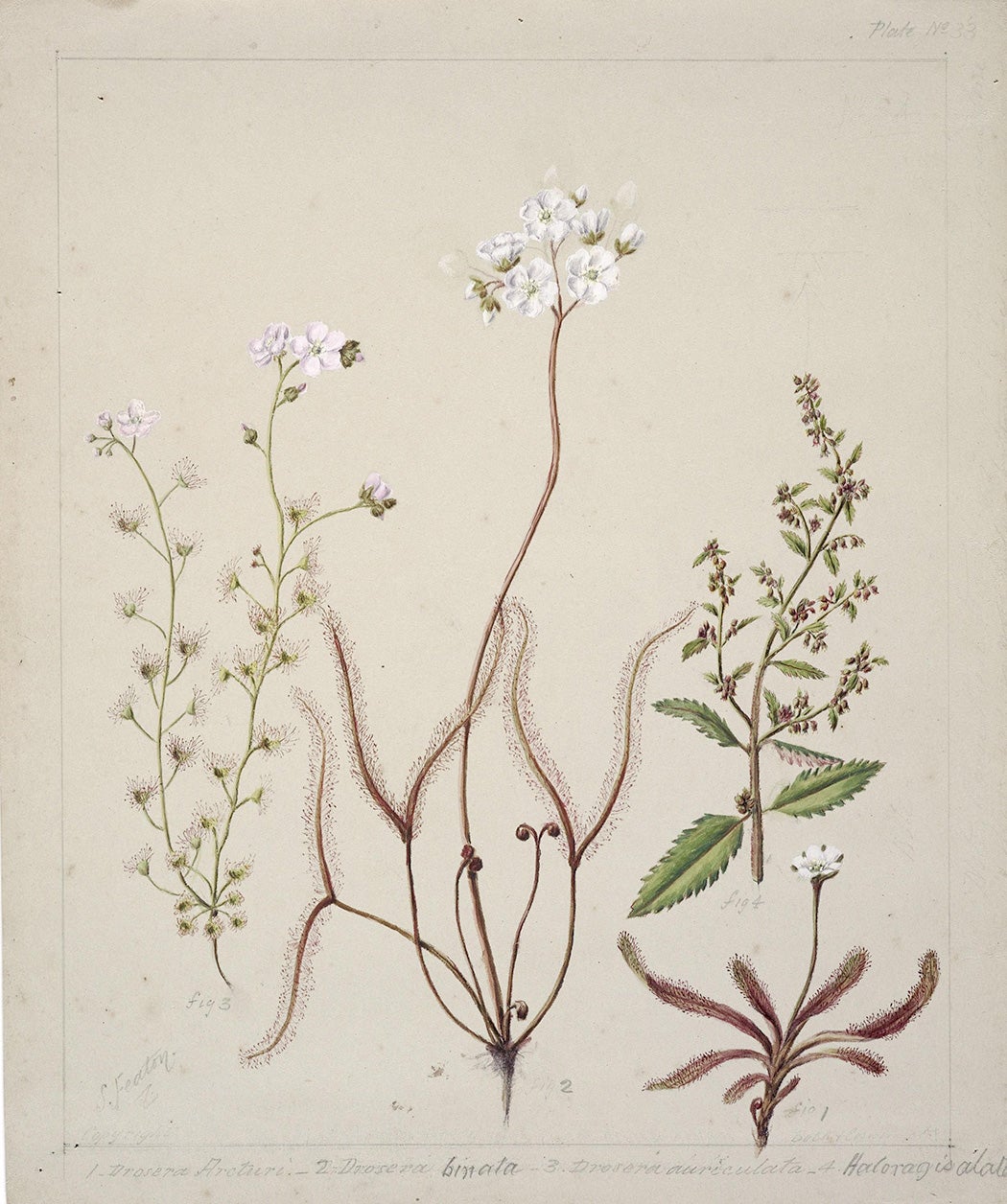
On the other side of the world, Southern Kwakiutl medical practitioners in British Columbia used sundews as a dermatological aid and love charm. Traditionally, the corms of tuberous species have also been consumed as a delicacy by Australian Aboriginal peoples. The extent to which colonial explorers appropriated knowledge about these plants from Indigenous peoples will likely never be fully known, but we can today at least see glimpses of how disparate groups incorporated the sundew into their respective cultural practices.

It appears that plant carnivory and the possibility of nourishment from insect prey were not discussed until colonial encounters with the Venus flytrap (Dionaea muscipula) in North America. However, the plant’s medicinal “virtues” did not go unnoticed by early modern European herbalists such as John Gerard, who described it as “a rare and singular remedy for all those that be in a consumption of the lungs” in his 1597 Generall historie of plantes. There even seem to be some midges or gnats in Gerard’s accompanying engraving of the sundew, but this is likely a printing error, and he certainly did not recognize their significance to the plant’s nutrition. The first published image of the sundew (or any carnivorous plant for that matter) had appeared a few decades earlier in Rembert Dodoens’s 1554 herbal Crüÿdeboeck, a copy of which is held in the Dumbarton Oaks rare book collection.
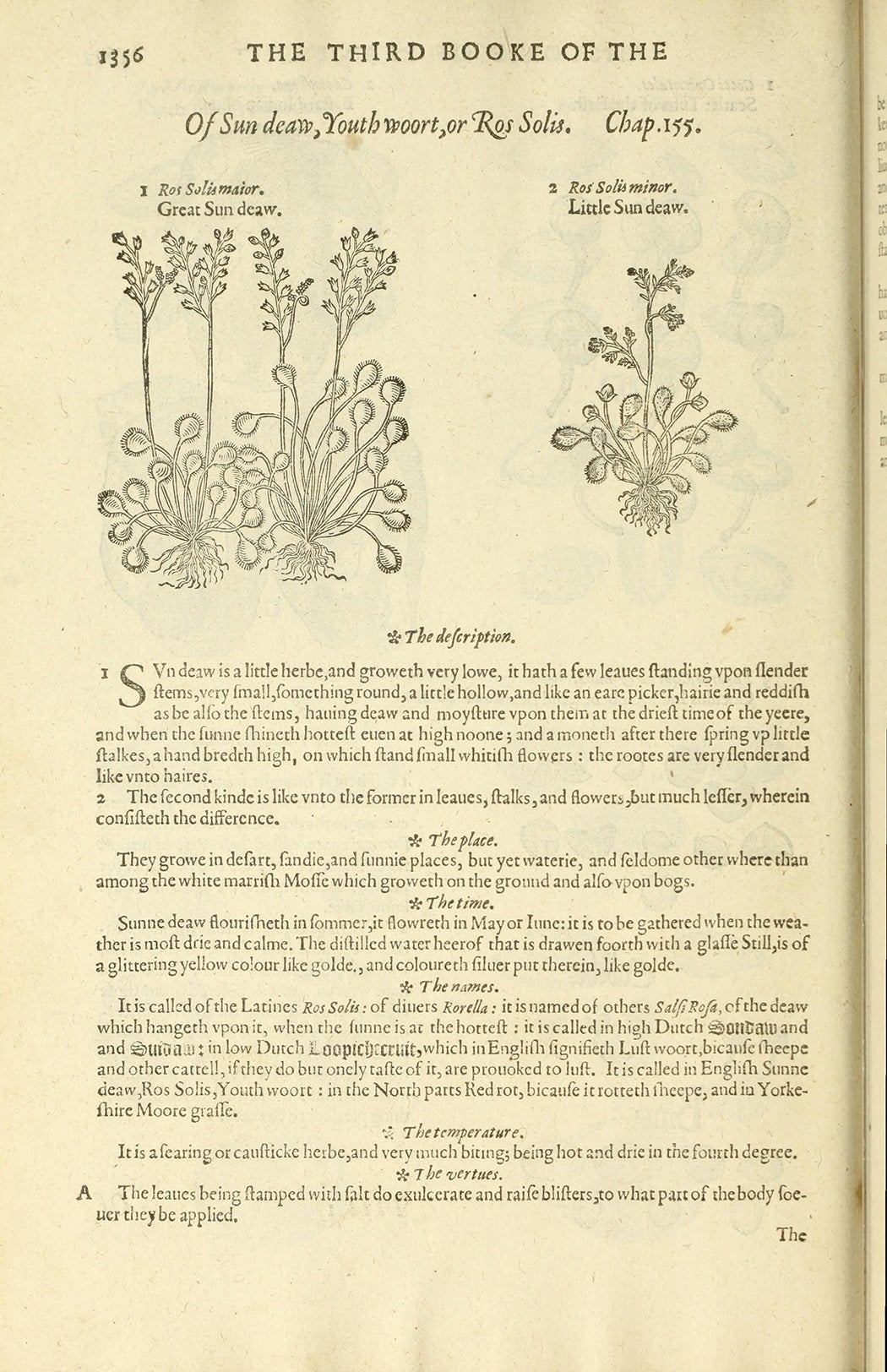
Several late eighteenth-century botanists attempted to make sense of the sundew. German physician and botanist Albrecht Wilhelm Roth devoted an entire chapter to the sundew as an ideal experimental subject for the investigation of “irritability” in leaves in his 1782 Beiträge zur Botanik. Roth was among the first to note the sensitivity of the sticky glandular hairs covering the leaves of the sundews Drosera rotundifolia and D. longifolia, which grew plentifully in his garden.
English naturalists were also grappling with the murderous habits of the sundew. In 1787 the English naturalist William Withering published the second edition of An Arrangement of British Plants, a bowdlerized version of Linnaean taxonomy that omitted any reference to sexual organs (i.e., pistils and stamens) in an attempt to make botany more suitable to a wider audience, in particular, women. His text brought Roth’s observations of the sundew to an English audience, corroborating them with accounts by Withering’s colleagues.
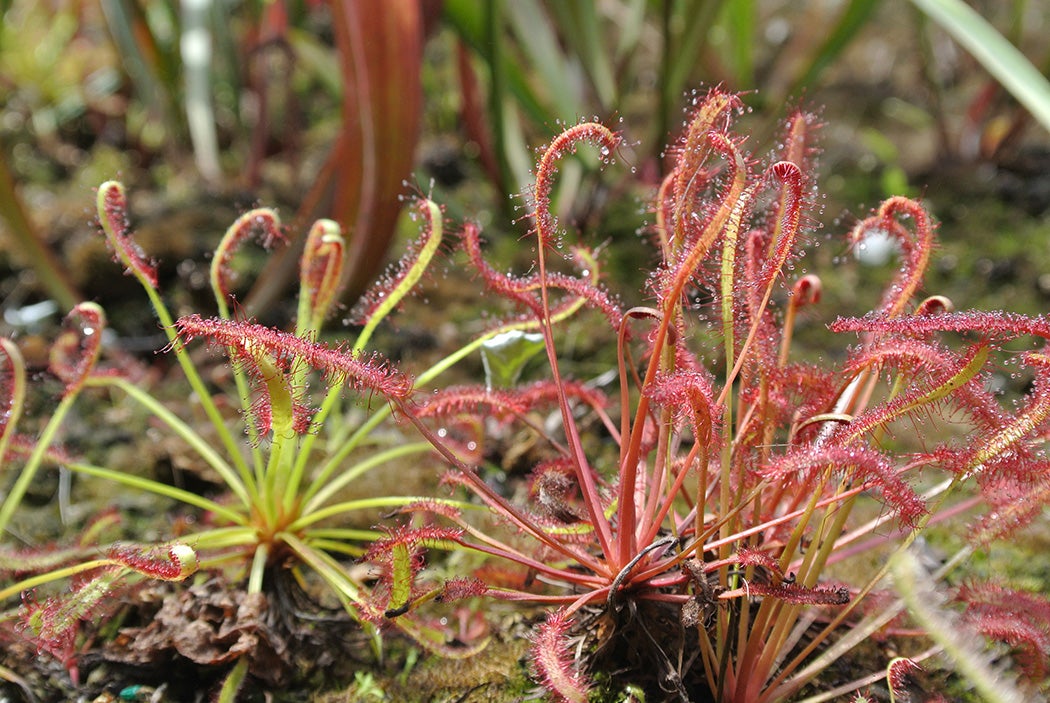
Erasmus Darwin, another notable English botanist and natural philosopher, discussed the sundew in the latter half of his two-part poem The Botanic Garden (1789). This text sought to display the Linnaean sexual system through poetic analogies of plant sexuality and human affairs, accompanied by Erasmus’s own botanical notes and observations. He was astonished at the beautiful destruction dealt by “Queen of the marsh” Drosera and other such murderous vegetables, but he erroneously claimed that they were simply defending themselves from would-be insect predators.
Erasmus Darwin’s grandson, Charles Darwin, was likewise enthralled. As early as 1860, soon after encountering the sundew Drosera rotundifolia on an English heath, the author of On the Origin of Species wrote, “I care more about Drosera than the origin of all the species in the world.” Darwin’s rigorous experimentation with the sundew and a slew of other carnivorous plants over the next decade and a half culminated in the publication of his monumental 1875 treatise on plant carnivory, Insectivorous Plants. His extensive correspondence with American naturalists, including Mary Treat and William Canby, contributed significantly to this work. Darwin’s son, Francis, in turn carried on his father’s legacy through his own experiments with Drosera.
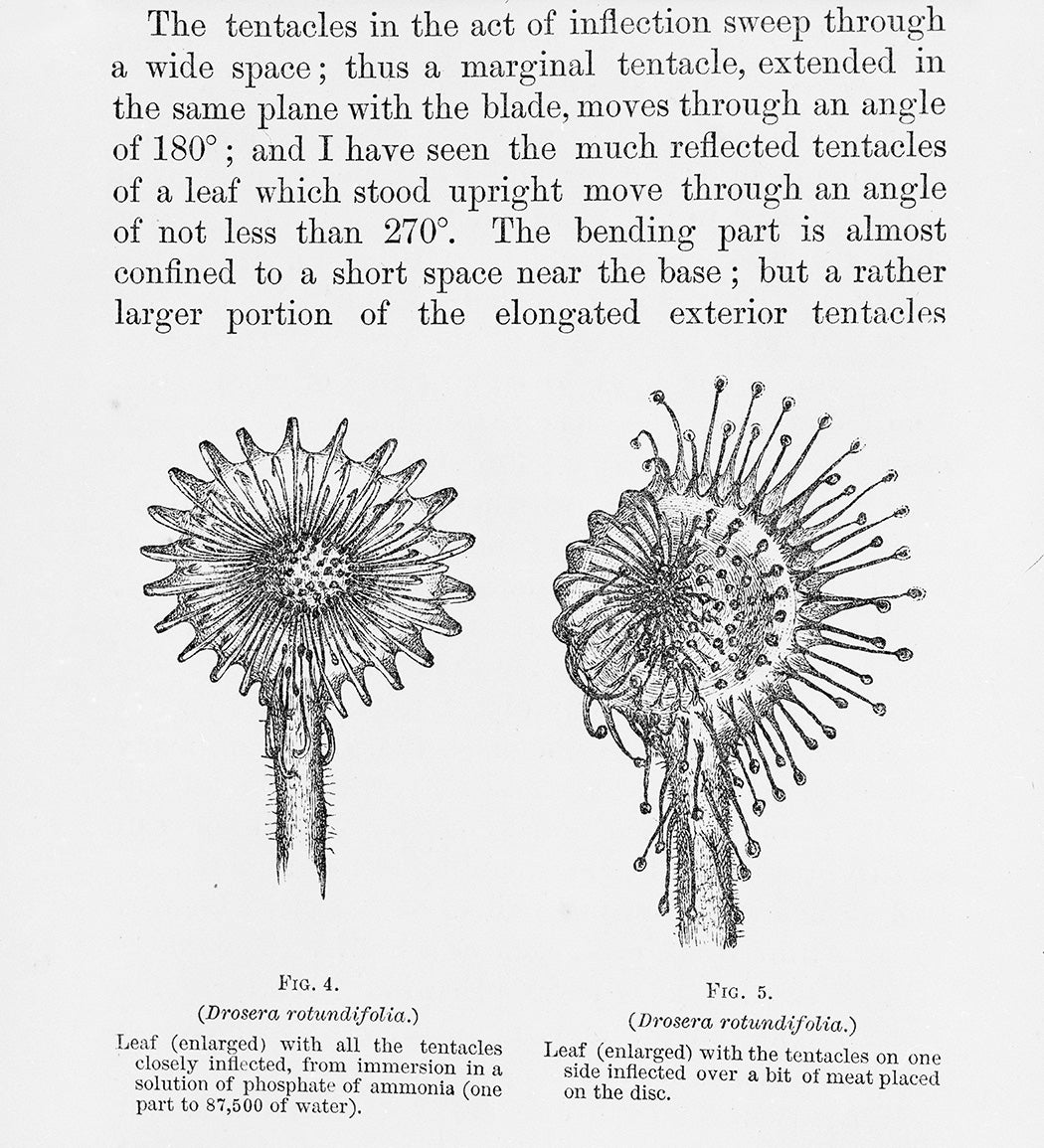
The sundew remains an organism of great scientific interest today. Ethnopharmacology as a field in part seeks to better understand modern uses for plant compounds found in traditional pharmacopeias. Scientists have only just begun to decipher the medicinal applications of the sundew, long prized for anti-inflammatory and antimicrobial chemical properties. Despite their global distribution, many species of sundew are threatened or endangered, and we may forever lose their untapped ethnopharmacological value. Indeed, two in every five plants are currently threatened by the global scale of anthropogenic climate change and habitat destruction.
Weekly Newsletter
Studies of the sundew have served to deepen our scientific understanding of the natural world, blurring the boundaries of taxonomic classification, galvanizing the spread of evolutionary theory, and yielding valuable ecological insights. Culturally, carnivorous plants have been used to challenge hierarchies of plant and animal life, as well as articulate social divisions of race, gender, and sexuality. They have been constantly redefined by the hugely diverse array of people struggling to make sense of them within various social and scientific contexts.
The Plant Humanities Initiative seeks to explore the unparalleled significance of plants like the sundew to human culture. Check out “Venus Flytrap: Queen of the Carnivorous Plants” on the Plant Humanities Lab to learn more about the fascinating history of carnivorous plants.
Support JSTOR Daily! Join our new membership program on Patreon today.
